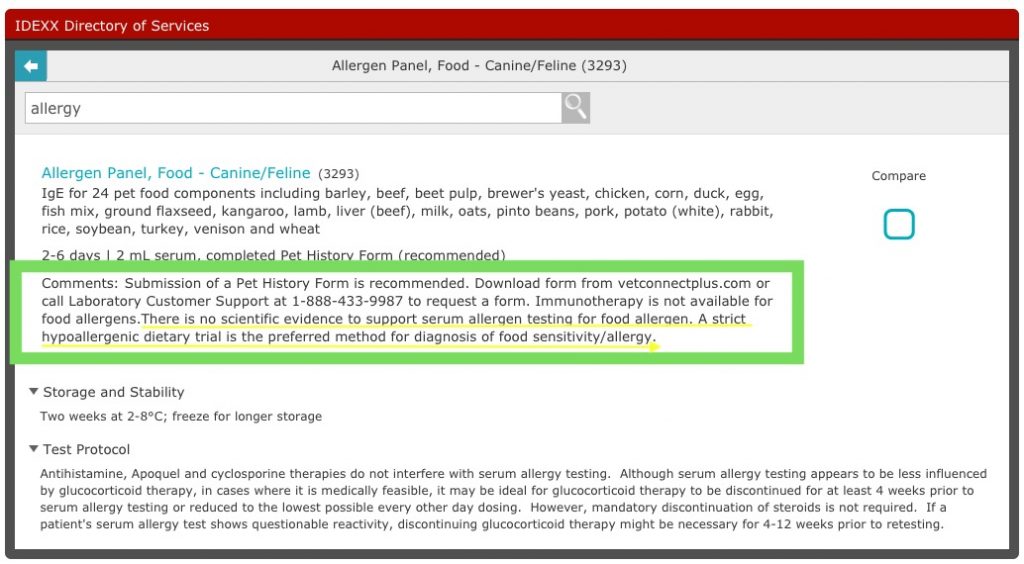Derm Spotlight: Testing for Food Allergy
Food Allergy vs Other Allergies
Skin allergies are a very common problem in dogs and cats; in our dermatology practice, itching of the skin or ears account for the majority of our appointments. Pet owner awareness of food allergy has greatly increased in recent years, likely due to marketing efforts of boutique dog food companies like Blue Buffalo (this company and many others have perpetuated the false notion that “limited ingredient” or “grain-free” diets are somehow better for dogs). Sadly, surface-level internet searches seem to provide mostly misconceptions about pet food allergy while science-based evidence is much harder for the average pet owner to find. We’re trying to help by wading through the research for you and presenting the most important facts.
When it comes to itchy dogs, food allergy is actually not that common. A 2018 study found that only 0.2% of dogs have a food allergy, compared to 1.8% of dogs having a flea-bite allergy and 3.6% of dogs having atopic dermatitis (environmental pollen or dust mite allergies) (1). That means flea-bite allergy is 9 times more common than food allergy and environmental allergies are 18 times higher!
If a food allergy is suspected, an elimination diet trial is the gold standard for making the diagnosis. That means putting the dog on a special diet with ingredients they’ve never been exposed to before and feeding only that for 8-10 weeks. After the dog is better, individual ingredients can be re-challenged to find out exactly what the pet is allergic to. It’s a lot of work to make sure a pet doesn’t accidentally get any treats or scraps of table food dropped on the floor and 8 weeks is a long time. Many pet owners struggle to keep the diet strict and wish there was an easier way to diagnose food allergy.

Elimination diet trial is the gold standard
Determining Best Test
There are a number of food allergy tests on the market, but unfortunately none of them are accurate. Blood allergy test results are all over the place. (2) Sometimes they show no positive reactions to a dog that is known (through diet trials and re-challenge) to have a food allergy. Sometimes they show tons of positive reactions in normal dogs that don’t have allergies at all. Some studies even showed that test results varied between the SAME blood sample sent secretly in different batches. Blood allergy tests for food are so inaccurate, the companies who offer them even put a disclaimer on the bottom of their website: “There is no scientific evidence to support serum(blood) allergen testing for food allergen. A strict hypoallergenic dietary trial is the preferred method for diagnosis of food sensitivity/allergy.” The company offering the test even admits that the test is not valid!

Idexx screen shot
There are also food allergy tests for saliva and hair offered. A study submitted samples from a known allergic dog, a normal dog, and FAKE samples (fur from a stuffed animal and water instead of saliva). (3) There was no significant difference in test results between any of the samples- even the fake ones! Saliva and hair allergy tests in dogs are completely bogus, so please don’t ever waste your money. I can only assume these laboratories continue to offer inaccurate tests because they want to make money, but we’ll continue to raise awareness to both pet owners and general veterinarians to avoid these tests.
In summary, blood, saliva, and hair tests for food allergy in pets are not accurate and the only way to diagnose food allergy is through an elimination diet trial. If diet changes have not helped your itchy pet, it may be that the right ingredients weren’t selected for the diet trial, or (more likely) it could mean food allergy is not your pet’s problem. Seeing a board-certified veterinary dermatologist can help solve your pet’s itching as quickly as possible.
If you would like to schedule your dog or cat for an allergy or dermatology consultation please call or visit us.
Additional Reading and Sources….
References:
- AVMA. Journal of AVMA, News. [Online] 2018. https://www.avma.org/javma-news/2018-07-15/banfield-few-pets-allergic-food-flea-environmental-allergies-rise.
- Critically Appraised Topic on Adverse Food Reactions of Companion Animals (4): Can We Diagnose Adverse Food Reactions in Dogs and Cats With in Vivo or in Vitro Tests? Ralf S Mueller, Thierry Olivry. 13(1):275., s.l. : BMC Vet Res. 2017 Aug 30;13(1):275., 2017, Vol. Aug 30;.
- Hair and Saliva Test Fails to Identify Allergies in Dogs. K Coyner, A Schick. 60(2):121-125, 2019, Vol. Feb.
- Jul, 07, 2020
- Disease Spotlight


